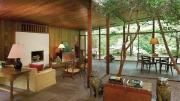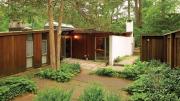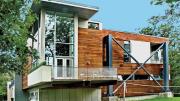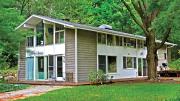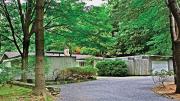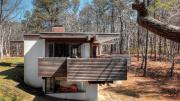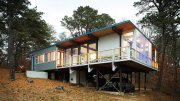Billed as “Lexington’s second revolution,” the profusion of mid-century modern homes built by architects largely influenced by Bauhaus founder Walter Gropius forms the center of Lextopia: Lexington’s Launch of Mid-Century Modern. It’s a multipronged exhibit, organized by the Lexington Historical Society, that explores the town’s significant pioneering role in the American modernist movement. A rare tour of four private dwellings designed by Henry B. Hoover, M.Arch. ’26, opens the show on May 31; the exhibit starting on June 19 chronicles the origins of modern communities, such as Six Moon Hill and Five Fields, and highlights original furnishings and dishware, along with the work of resident architects such as Hugh Stubbins, M.Arch. ’35, Sally Harkness, and Benjamin C. Thompson, who founded Design Research in Harvard Square. (Gallery discussions are slated for this summer, and a second, larger house tour concludes the exhibit on October 4.)
The society typically focuses on Lexington’s pivotal importance to the early days of the American Revolution: it manages three museums that have all been restored within the last eight years—the Buckman and Munroe Taverns and the Hancock-Clarke House—and runs related educational programs and events. This foray into modernism, explains Elaine C. Doran, the society’s curator and archivist, reflects a growing recognition that, “to our knowledge, there really is no other concentration of modernist neighborhoods of this size in the country.” The “influx of professors and engineers and mathematicians and scientists,” she adds, also permanently altered the town’s character. “We did not have this kind of demographic before; we had been a quiet, rural, farming community.”
Hoover and American architect Edwin Goodell were designing modern structures before Gropius fled Nazi Germany and arrived in Cambridge in 1937 to chair the department of architecture at the Harvard Graduate School of Design. But the earliest of the town’s modernist cul-de-sacs, Six Moon Hill (1948) and Five Fields (1951), were planned as experimental utopian communities by The Architects Collaborative (TAC), founded by Gropius and others, including Harkness and Thompson, in 1945. The firm would soon grow to take on many more who trained at Harvard, where Gropius and his Bauhaus colleague Marcel Breuer were influential forces for years. Many of these designers, Doran says, were drawn by Lexington’s proximity to Cambridge and the availability of inexpensive, open land.
The two original neighborhoods were quickly followed by others. Middle Ridge (1955) was developed by another Gropius student, Carl Koch ’34, M.Arch. ’37, who also designed the 1950s homes in the Conantum community, in Concord. (Thousands of his Techbuilt homes, assembled from prefabricated elements, also appeared across the country.) Peacock Farm (1953), Rumfield Road/Shaker Glen (1959-60), and Upper Turning Mill (1962-65) were based on designs by MIT-trained architects Walter Pierce and Danforth Compton.
Other custom-built modern homes and civic-minded enclaves still exist in Greater Boston—such as Kendall Common in Weston, Snake Hill in Belmont, and Brown’s Wood in Lincoln—and are dotted throughout New England. Their initial popularity coincided with the arrival of European designers and intellectuals who fled World War II, a nascent American push to modernism, and the postwar “building boom and optimism about design and technology’s roles in progress,” says Peter McMahon, founding director of the Cape Cod Modern House Trust, which has restored and now manages three homes in Wellfleet. (For further reading on preserving modernist homes in the region, visit https://harvardmagazine.com/2007/09/modern-and-historic.html.)
As those houses have aged, he adds—with many already demolished and others under threat—local historical societies, preservation groups, and museums are increasingly apt to add modernism’s artifacts to their repertoires. Historic New England, for example, has long owned and managed the Gropius House in Lincoln, Massachusetts, where Friends of Modern Architecture/Lincoln helps preserve and promote the eclectic array of modern homes in town. On October 9, the Concord Museum mounts its own Middlesex County Modernism show (www.concordmuseum.org).
Of this surge in activity and interest, McMahon also notes, “Post-modernist structures have aged very badly, and nowadays architecture is just very chaotic. Twentieth-century modernism was, in retrospect, a golden age.”
Lextopia’s co-curator, the writer and documentarian Rick Beyer, sees relevant, contemporary themes, such as “climate change and the environment and fostering community, that are making some of these houses very relevant to people again.” Modernists incorporated their ideals into their designs, emphasizing utility and affordability, as well as flexible private and public spaces. These were not McMansions, but human-scaled, tightly constructed homes with built-ins, spare furnishings, and a dearth of structural ornamentation. “The practical, minimalist aesthetics are appealing,” Beyer notes, and support current efforts to curb energy use. The open layouts promoted group gatherings, while bathrooms and bedrooms tended to be small and peripheral.
At Six Moon Hill (where Benjamin Thompson lived for 16 years in a house he designed; his widow, Jane, will give a gallery talk this summer), much depended on group decisions and stewardship. “You didn’t just buy a house, you bought a way of life,” says Doran, who has recorded oral histories with former residents. “The neighbors were like one big family. The kids all played together and you never knew which house they would end up in for dinner; you just accepted whoever came over.” Beyer is creating a video for the exhibit using clips from 8 mm home movies that reflect daily life in these communities—such as the annual pool clean-up day at Six Moon Hill. “I think some of the people who were designing these neighborhoods 50 years ago were thinking about the same things we are today: how do you bring people together and create positive interactions in a community?” he adds. “Nowadays so many people live shut up and isolated.”
Modernists, again presaging current concerns, also valued human connections to the natural world. Residences were carefully sited to blend in with the existing rural landscapes. Often, plate-glass walls blurred boundaries between inside and outside; in some cases, as in a 1957 Peacock Farm home designed by Henry Hoover, “trees are growing up in the middle of the living room,” notes Doran. A woman who grew up in the house told her that “staring out those windows in the winter when it was snowing was just like being inside a snow globe.”
That property is on the May 31 tour, as is the much earlier 1937 home that Hoover built for himself and his young family in Lincoln, Massachusetts, which remains in the family, according to his children, Henry B. Hoover Jr. and Lucretia Hoover Giese. Proceeds from the tour will help support their forthcoming book, Breaking Ground: Henry B. Hoover, New England Modern Architect. The structure, Giese notes in an e-mail to the historical society, reflects his “foremost concern with siting and spatial organization, which accentuated the house’s integration with the land. Overlooking the Cambridge Reservoir, the house remains eminently livable and beautiful.”
Modernism also migrated to Cape Cod, primarily Wellfleet and Truro, starting in the late 1930s. The Cape Cod Modern House Trust last year published the stunning Cape Cod Modern, coauthored by McMahon and Christine Cipriani, on the history and range of experimental homes on the outer Cape. The trust rents out its three restored homes, sponsors an artist/scholar residency, and runs tours and events, including the symposium “Rural Communities Today,” on May 30-31.
Gropius, Breuer, and other artists, writers, and arts patrons (including Peggy Guggenheim), began renting cottages there—primarily at the behest of Jack Charles Phillips Jr. ’30, Ds ’39. Phillips, descended from the founders of Phillips Andover and Phillips Exeter academies, had recently returned from studying painting in France and chose to settle on 800 acres he had inherited in Wellfleet. Even though Provincetown already had an art colony, much of the outer Cape “was wilderness, a no-man’s land,” at the time, McMahon says—and Phillips built the first modernist house there in 1938. Known as “The Paper Palace,” it was made of pressed-paper wallboard.
“He was the paterfamilias,” McMahon adds, for what soon became a close-knit communal blend of the European architects and academics and another group of self-taught builders and artistic experimenters, such as Princeton graduate John “Jack” Hughes Hall and Hayden Walling, who tended toward radical philosophies. In 1944, architect Serge Chermayeff, who was friends with Gropius and Breuer and led the architecture department at Harvard in the 1950s and early 1960s, bought the cabin he had rented from Phillips; it became an informal think tank for the bohemian enclave. Chermayeff eventually turned the cabin into a connected series of right-angled structures painted in primary colors. His son, Cambridge architect Peter Chermayeff ’57, M.Arch. ’62, now summers there; he has been an active supporter of the trust and will host part of the May symposium.
“The Cape Cod land was this blank slate and in the early days they all built stuff out there, mostly of found materials,” notes McMahon. With no commercial pressures, they “designed homes to suit themselves and their friends, often incorporating old shacks and a prefab army barracks. You had this very high-concept, low-budget utopian community of people who also loved nature, fishing, and farming.”
By 1961 the land under these creations became the Cape Cod National Seashore. Pre-1959 structures were “grandfathered in,” but more than a hundred modern houses built as the legislation was debated ultimately became the property of the National Park Service (NPS). They sat vacant, sometimes for decades, and fell into disrepair; by the 1990s most had been condemned.
McMahon, who grew up vacationing on the Cape, moved there from Manhattan in 2003. He became fascinated by the history and the homes, and focused on researching, archiving—and then saving—what he could. He and others formed the nonprofit trust in 2007 and have worked closely with the park service to identify seven of the 100 NPS-owned buildings that were historically important. Of those, two have been fixed up by the park service itself and three meticulously restored by the trust, and are now protected as part of the National Register of Historic Places. The trust holds long-term leases on the three homes: the Kugel/Gips House (1970, by Charles Zehnder); the Hatch House (1961, Jack Hughes Hall); and the Weidlinger House (1953; Paul Weidlinger, an engineer, was a former Harvard faculty member).
The Weidlinger home sits on a pond, a short paddle from Breuer’s cottage. A wooden box on a platform, it juts out in front atop concrete piers. A row of windows faces the woods and water, offering views of the light, wind, trees, and skies rearranging the landscape into a constantly evolving painting.
As a movement, modernism’s emphasis on nature, form, and simplicity make it particularly agile. If McMahon is right—that “post-modernist structures have aged very badly”—the modernist aesthetics seem only to ripen. “There’s the sense that modern has been classical, and now it’s modern again,” muses Lexington’s Rick Beyer. “It’s timeless: what’s old is new again.”
